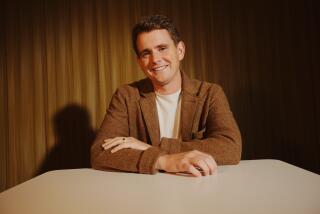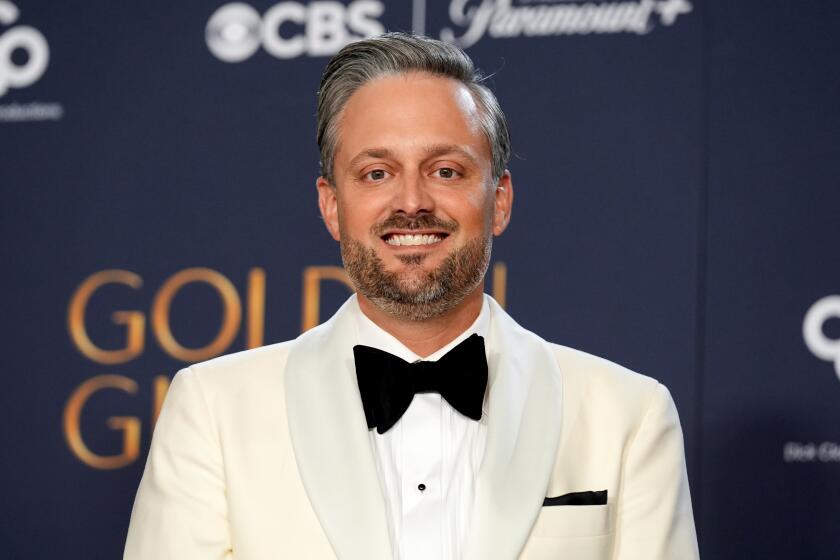Can YouTube make it big on the small screen?

Susanne Daniels, global head of original content for YouTube, discusses YouTube Red, the company’s new subscription service.
- Share via
The new TV series “Single by 30” follows two high school friends who make a pact over French fries and milkshakes to marry one another if they’re both single at 30.
The Los Angeles-based comedy is not a Netflix, Amazon or CW production.
Instead, “Single by 30” comes courtesy of YouTube Red, the ad-free subscription service recently launched by the global streaming giant.
The Internet’s dominant video site was once a Hollywood pariah, charming young viewers with viral videos of dancing animals and roller-skating babies and serving up pirated TV and film content. But like a teen coming of age, YouTube is entering a new phase.
Because of the growing competition for eyeballs, YouTube can no longer rely solely on amateur snippets and user-generated videos to drive traffic and advertising to its site. So it is financing and distributing a roster of original productions targeting younger audiences who aren’t watching traditional television shows and movies the way their parents did.
“Single by 30,” which debuted last month, is among the 20 television shows, documentaries and films that YouTube plans to introduce this year as part of its $9.99 monthly service. The productions star popular YouTube personalities who already have online followings.
When YouTube Red launched in October, the main draw was access to YouTube’s robust music library and viewing of videos without ads. The push into original TV series and movies this year is meant to create a more comprehensive service that will provide users with enough incentive to keep paying — and to nudge their friends to do the same.
Google-owned YouTube has dabbled with original content in the past, investing $200 million in 2011 to pay for more than 100 Web channels. That ambitious effort, which included opening studio spaces in Los Angeles, New York and London that YouTube creators could access for free, largely misfired.
Can YouTube have more success in the paid streaming television business? Some industry analysts are skeptical, saying YouTube faces many hurdles.
They are the pioneers and the category leaders when it comes to short, snackable, free video.
— Paul Verna, a senior analyst at digital media research firm eMarketer
Chief among them is the fierce competition. YouTube is playing catch-up to more established players such as Netflix, Amazon and Hulu. YouTube Red charges about the same monthly fee as those services without the same pedigree of content.
What’s more, in a crowded marketplace, it’s harder for new series to stand out. This year will see 430 to 450 scripted TV shows — a number that could climb to 500 in 2017, according to research by FX Networks.
Then there’s the fundamental challenge of convincing users that they should pay for entertainment they used to get for free. In some ways, a pay tier runs counter to YouTube’s DNA.
The most-read Entertainment stories this hour »
“It’s a hard behavior to change, especially because YouTube has been doing free videos longer than anyone, and they’ve done it better than anyone,” Paul Verna, a senior analyst at digital media research firm eMarketer. “They are the pioneers and the category leaders when it comes to short, snackable, free video.”
To help break through the clutter, YouTube has tapped veteran TV executive Susanne Daniels, who has long delved in youth programming, with stretches at MTV and the WB network.
“It is a peak-TV era, I agree with that,” said Daniels, seated in a conference room at YouTube’s offices in Beverly Hills. “But we’re playing in a unique lane.”
Indeed, one advantage that YouTube has is a direct pipeline to millennials and Gen-Zers, who are a source of mystery to much of Hollywood. YouTube stars rank higher among teens than some of the biggest celebrities in film, TV and music.
Not surprisingly, Red features popular YouTube personalities in its productions, such as Lilly Singh’s documentary “A Trip to Unicorn Island,” “PewDiePie’s reality series “Scare PewDiePie,” AwesomenessTV’s movie “Dance Camp” and Rooster Teeth’s film Lazer Team. (“Scare PewDiePie” and “Foursome” were recently renewed for second seasons).
YouTube Red recently announced a film-to-TV adaptation from Lionsgate of the “Step Up” movie franchise that will include the original film’s stars, Channing Tatum and Jenna Dewan, as executive producers.
YouTube distributes and finances the projects, giving talent access to infrastructure and resources they wouldn’t otherwise have. Most are half-hour comedies and dramas with budgets from $400,000 to $1 million, according to people familiar with the financials. That’s well below the $1-million to $3-million budget range for half-hour shows on conventional TV.
Finding material with built-in audiences isn’t a problem for YouTube. Philip Wang and Wesley Chan, the duo behind “Single by 30,” had been on YouTube’s radar for years after amassing nearly 2.5 million subscribers on their video channel with such shorts as “What Asian Parents Don’t Say” and “Accidental Racism.”
“Working with YouTube stars is different from what most other content providers are doing right now,” Daniels said. They “come with a lot of proactive ideas because they’ve made themselves into stars. Philip and Wes have a very strong vision. They’ve been doing this for years.”
YouTube has long been praised for offering a platform for diverse voices. Issa Rae’s YouTube series “Awkward Black Girl,” for example, paved for the way for her forthcoming HBO series, “Insecure.”
YouTube is intent on carrying that over to Red. “Single by 30” is populated with people of color, many of them Asian American.
“Something like YouTube Red is a dream,” Wang said. “For so long, we’ve had TV companies and studios turn down ideas because they didn’t want an Asian American lead or they didn’t think our fans were real. Instead of chasing the traditional Hollywood model, we stuck with the platform that has always accepted the types of stories we want to make.”
It’s too soon to tell if YouTube will find its own “Orange Is the New Black” or “Transparent” for the younger set.
YouTube, which has more than 1 billion unique users monthly, has not disclosed subscriber figures for Red. Some analysts suspect the numbers are likely to be weak given that the service has flown under the radar since its launch.
YouTube Red needs to be successful in order to continue funding original content. They’re not in a position to throw away money.
— Eunice Shin, managing director at Manatt Digital
The metrics for measuring success in the digital world are different from traditional TV, Daniels said.
“With linear TV, you have to think about the lead-in and the lead-out,” she said. “I don’t have to think about that as much anymore [on YouTube]. You think about: ‘What are they going to click on when they finish?’ “
Although YouTube will continue to make most of its money through advertising, Red could give Google (and its holding company, Alphabet) a valuable new revenue stream.
According to a report from Credit Suisse, YouTube is expected to convert 3% of its users to Red subscribers over the next five years, with paying subscribers estimated to reach 5.7 million by the end of 2016 and climbing to 61 million by 2022. By comparison, Netflix had 66 million paying subscribers as of the third quarter of 2015.
“The point of doing YouTube Red is to keep people on the platform, to keep them engaged,” said Eunice Shin, managing director at Manatt Digital, a consulting, venture and legal services firm. “Even though YouTube brings in a fraction of what matters to Google, in the grand scheme, YouTube Red needs to be successful in order to continue funding original content. They’re not in a position to throw away money.”
Some analysts think YouTube will create more of a ripple than a wave in the pay TV business.
“There’s not a lot of risk for YouTube,” Verna said. “And when you don’t have a lot at stake in something, sometimes you don’t do it with the kind of wild abandon and bold decision-making that you might need to compete.”
For Daniels, it’s too early to say how original programming on YouTube Red is faring.
“I don’t have all the answers yet,” she said. “We keep calling this year the Great Big Experiment.”
Twitter: @villarrealy
More to Read
From the Oscars to the Emmys.
Get the Envelope newsletter for exclusive awards season coverage, behind-the-scenes stories from the Envelope podcast and columnist Glenn Whipp’s must-read analysis.
You may occasionally receive promotional content from the Los Angeles Times.






